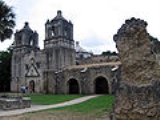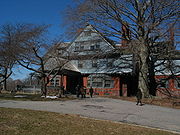
National Historical Park
Encyclopedia
National Historic Sites are protected area
s of national historic significance in the United States. A National Historic Site usually contains a single historical feature directly associated with its subject. A related but separate designation, the National Historical Park, is an area that generally extends beyond single properties or buildings, and its resources include a mix of historic and sometimes significant natural features.
As of 2010, there were 41 National Historical Parks measuring 119,049 acres (481.7 km²) and 78 National Historic Sites measuring 21,677 acres (87.7 km²). Most National Historical Parks and National Historic Sites are managed by the National Park Service
. Some federally-designated sites are privately owned, but are authorized to request assistance from the National Park Service as affiliated areas.
As of October 15, 1966, all historic areas, including National Historical Parks and Historic Sites, in the National Park System are automatically listed on the National Register of Historic Places
. There are also about 80,000 National Register of Historic Places
sites, the large majority of which are neither owned nor managed by the National Park Service. Of these, about 2400 have further been designated as National Historic Landmark
sites.
 National Historic Sites are federally owned and administered. The proper noun term "National Historic Site" refers to federally staffed properties, usually federally owned. There are currently 90 National Historic Sites, of which 78 are official NPS units, 11 are NPS affiliated areas, one is managed by the US Forest Service, and one by the Bureau of Land Management
National Historic Sites are federally owned and administered. The proper noun term "National Historic Site" refers to federally staffed properties, usually federally owned. There are currently 90 National Historic Sites, of which 78 are official NPS units, 11 are NPS affiliated areas, one is managed by the US Forest Service, and one by the Bureau of Land Management
. Some other federally administered sites are National Historical Parks.
Derived from the Historic Sites Act of 1935, a number of Historic Sites were established by United States Secretaries of the Interior
, but most have been authorized by acts of Congress
. In 1937, the first National Historic Site was created in Salem, Massachusetts in order to preserve and interpret the maritime history of New England and the United States.
There is one International Historic Site in the US park system, a unique designation given to Saint Croix Island
, Maine, on the New Brunswick
border. The title, given to the site of the first permanent French settlement in America, recognizes the influence that has had on both Canada and the United States. The National Park Service does not distinguish among these designations in terms of their preservation or management policies.

In the United States, sites are "historic", while parks are "historical". The National Park Service explains that a site can be intrinsically historic, while a park is a modern legal invention. As such, a park is not itself "historic", but can be called "historical" when it contains historic resources. It is the resources which are historic, not the park.
Klondike Gold Rush International Historical Park was formally established in 1998 by the United States and Canada, the centennial of the gold rush
it commemorates. The park comprises Klondike Gold Rush National Historical Park
in Washington and Alaska
, and Chilkoot Trail National Historic Site
in British Columbia. It was this trail which so many prospectors took to fortunes in the Klondike River
district of Yukon
.
Protected area
Protected areas are locations which receive protection because of their recognised natural, ecological and/or cultural values. There are several kinds of protected areas, which vary by level of protection depending on the enabling laws of each country or the regulations of the international...
s of national historic significance in the United States. A National Historic Site usually contains a single historical feature directly associated with its subject. A related but separate designation, the National Historical Park, is an area that generally extends beyond single properties or buildings, and its resources include a mix of historic and sometimes significant natural features.
As of 2010, there were 41 National Historical Parks measuring 119,049 acres (481.7 km²) and 78 National Historic Sites measuring 21,677 acres (87.7 km²). Most National Historical Parks and National Historic Sites are managed by the National Park Service
National Park Service
The National Park Service is the U.S. federal agency that manages all national parks, many national monuments, and other conservation and historical properties with various title designations...
. Some federally-designated sites are privately owned, but are authorized to request assistance from the National Park Service as affiliated areas.
As of October 15, 1966, all historic areas, including National Historical Parks and Historic Sites, in the National Park System are automatically listed on the National Register of Historic Places
National Register of Historic Places
The National Register of Historic Places is the United States government's official list of districts, sites, buildings, structures, and objects deemed worthy of preservation...
. There are also about 80,000 National Register of Historic Places
National Register of Historic Places
The National Register of Historic Places is the United States government's official list of districts, sites, buildings, structures, and objects deemed worthy of preservation...
sites, the large majority of which are neither owned nor managed by the National Park Service. Of these, about 2400 have further been designated as National Historic Landmark
National Historic Landmark
A National Historic Landmark is a building, site, structure, object, or district, that is officially recognized by the United States government for its historical significance...
sites.
National Historic Sites

Bureau of Land Management
The Bureau of Land Management is an agency within the United States Department of the Interior which administers America's public lands, totaling approximately , or one-eighth of the landmass of the country. The BLM also manages of subsurface mineral estate underlying federal, state and private...
. Some other federally administered sites are National Historical Parks.
Derived from the Historic Sites Act of 1935, a number of Historic Sites were established by United States Secretaries of the Interior
United States Secretary of the Interior
The United States Secretary of the Interior is the head of the United States Department of the Interior.The US Department of the Interior should not be confused with the concept of Ministries of the Interior as used in other countries...
, but most have been authorized by acts of Congress
United States Congress
The United States Congress is the bicameral legislature of the federal government of the United States, consisting of the Senate and the House of Representatives. The Congress meets in the United States Capitol in Washington, D.C....
. In 1937, the first National Historic Site was created in Salem, Massachusetts in order to preserve and interpret the maritime history of New England and the United States.
There is one International Historic Site in the US park system, a unique designation given to Saint Croix Island
Saint Croix Island, Maine
Saint Croix Island , long known to locals as Dochet Island, is a small uninhabited island in Maine near the mouth of the Saint Croix River that forms part of the International Boundary separating Maine from New Brunswick....
, Maine, on the New Brunswick
New Brunswick
New Brunswick is one of Canada's three Maritime provinces and is the only province in the federation that is constitutionally bilingual . The provincial capital is Fredericton and Saint John is the most populous city. Greater Moncton is the largest Census Metropolitan Area...
border. The title, given to the site of the first permanent French settlement in America, recognizes the influence that has had on both Canada and the United States. The National Park Service does not distinguish among these designations in terms of their preservation or management policies.
National Historical Parks

In the United States, sites are "historic", while parks are "historical". The National Park Service explains that a site can be intrinsically historic, while a park is a modern legal invention. As such, a park is not itself "historic", but can be called "historical" when it contains historic resources. It is the resources which are historic, not the park.
Klondike Gold Rush International Historical Park was formally established in 1998 by the United States and Canada, the centennial of the gold rush
Klondike Gold Rush
The Klondike Gold Rush, also called the Yukon Gold Rush, the Alaska Gold Rush and the Last Great Gold Rush, was an attempt by an estimated 100,000 people to travel to the Klondike region the Yukon in north-western Canada between 1897 and 1899 in the hope of successfully prospecting for gold...
it commemorates. The park comprises Klondike Gold Rush National Historical Park
Klondike Gold Rush National Historical Park
Klondike Gold Rush National Historical Park is a United States National Historical Park commemorating the Klondike Gold Rush of the late 1890s. The gold rush was in the Yukon Territory, and this park comprises staging areas for the trek there, and routes leading in its direction...
in Washington and Alaska
Alaska
Alaska is the largest state in the United States by area. It is situated in the northwest extremity of the North American continent, with Canada to the east, the Arctic Ocean to the north, and the Pacific Ocean to the west and south, with Russia further west across the Bering Strait...
, and Chilkoot Trail National Historic Site
Chilkoot Trail
The Chilkoot Trail is a 33 miles trail through the Coast Mountains that leads from Dyea, Alaska in the United States, to Bennett, British Columbia in Canada....
in British Columbia. It was this trail which so many prospectors took to fortunes in the Klondike River
Klondike River
The Klondike River is a tributary of the Yukon River in Canada that gave its name to the Klondike Gold Rush. The Klondike River has its source in the Ogilvie Mountains and flows into the Yukon River at Dawson City....
district of Yukon
Yukon
Yukon is the westernmost and smallest of Canada's three federal territories. It was named after the Yukon River. The word Yukon means "Great River" in Gwich’in....
.

